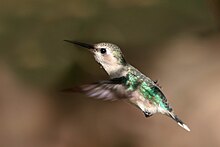Bee hummingbird
| Bee hummingbird | |
|---|---|
 |
|
| immature male | |
 |
|
| Female in flight Both at Palpite, Cuba |
|
| Scientific classification | |
| Kingdom: | Animalia |
| Phylum: | Chordata |
| Class: | Aves |
| Order: | Apodiformes |
| Family: | Trochilidae |
| Genus: | Mellisuga |
| Species: | M. helenae |
| Binomial name | |
|
Mellisuga helenae (Lembeye, 1850) |
|
The bee hummingbird, zunzuncito or Helena hummingbird (Mellisuga helenae) is a species of hummingbird regarded as the world's smallest bird.
With a mass around 1.6–2 g (0.056–0.071 oz) and a length of 5–6 cm (2.0–2.4 in), it is the smallest living bird. The male has a green pileum and fiery red throat, iridescent gorget with elongated lateral plumes, bluish upper parts, and the rest of the underparts mostly greyish white. The male is smaller than the female. The female is green above, whitish below, with white tips to the outer tail feathers. Compared to other small hummingbirds, which often have a slender appearance, the bee hummingbird looks rounded and chunky.
Female bee hummingbirds are bluish green with a pale gray underside. The tips of their tail feathers have white spots. During the mating season, males have a reddish to pink head, chin, and throat. The female lays only two eggs at a time, each about the size of a coffee bean.
The smallest bird in the world, its weight is less than 2 grams or about equal in mass to a United States dime. As its name suggests, it is scarcely larger than a bee. Like all hummingbirds, it is a swift, strong flier.
The brilliant, iridescent colors of the bee hummingbird's feathers make the bird seem like a tiny jewel. The iridescence is not always noticeable, but depends on the angle at which a person looks at the bird. The bird's slender, pointed bill is adapted for probing deep into flowers. The bee hummingbird feeds mainly on nectar, and an occasional insect or spider, by moving its tongue rapidly in and out of its mouth. In the process of feeding, the bird picks up pollen on its bill and head. When it flies from flower to flower, it transfers the pollen. In this way, it plays an important role in plant reproduction. In one day, the bee hummingbird may visit 1,500 flowers.
...
Wikipedia

